MARIANI’S
December
28, 2008
NEWSLETTER
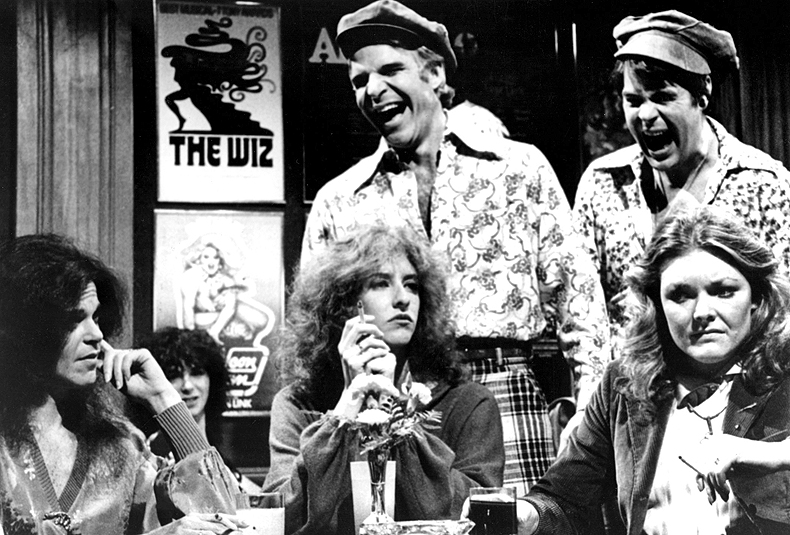
HAPPY NEW YEAR!
~~~~~~~~~~~~~~~~~
SUBSCRIBE AND
UN-SUBSCRIBE: You may subscribe anyone you wish
to this newsletter--free of charge--by
clicking here.
~~~~~~~~~~~~~~~~~
In
This Issue
NEW YORK CORNER: NYC's BEST NEW RESTAURANTS OF 2008 by John Mariani
NOTES FROM THE WINE CELLAR: THE MYTH OF THE CHABLIS MONOLITH by Brian Freedman
QUICK BYTES
~~~~~~~~~~~~~~~
 COPENHAGEN
COPENHAGENPart One
by John Mariani
First things first: It's pronounced "Copen-HAY-gen," not "Copen-HAH-gen," a mistake I learned soon after arriving in this beautiful sea-bound Danish city. The common error seems to stem from a single source that has provided most Americans with their storybook image of the city--the song "Wonderful, Wonderful Copenhagen," sung by Danny Kaye in the 1952 movie "Hans Christian Anderson," wherein Kaye pronounced it with the "HAH" rather than the "HAY."
Wonderful,
wonderful Copenhagen, friendly old girl of a town,
'Neath her
tavern light on this merry night
Let us clink
and drink one down
To
wonderful, wonderful Copenhagen salty old queen of the sea.
Once I
sailed away but I'm home today
Singing
Copenhagen, wonderful, wonderful Copenhagen for me!
It should be stated immediately that finding a Dane who does not to speak English would be difficult indeed. From first grade onward they are taught English, and other languages later on, so that it is yet again one of those distressing realizations to find Europeans have fluency in several languages, while Americans can barely speak their own well. Thus, there is no language barrier in Denmark, so for those for whom language is an off-putting problem, Copenhagen is a breeze.
Second, the Danes are extremely hospitable people--reported to be the happiest people in Europe, owing to a a highly taxed nanny state that actually works, albeit with a population of only 5 million inhabitants. Which means that the Danes are in the forefront of windmill technology (they scotched nuclear some years ago), they have excellent publics schools, full medical coverage, five weeks' vacation, and few fears about how old age will affect their caretaking. In an ironic twist, the excessive tax on buying a new car--180 percent!--forces Danes to use bicycles, which in turn provides them with cardiovascular benefits along with the joy of pedaling through pretty streets in a city that could easily be walked about in three hours or so. It all depends on what you want to see.
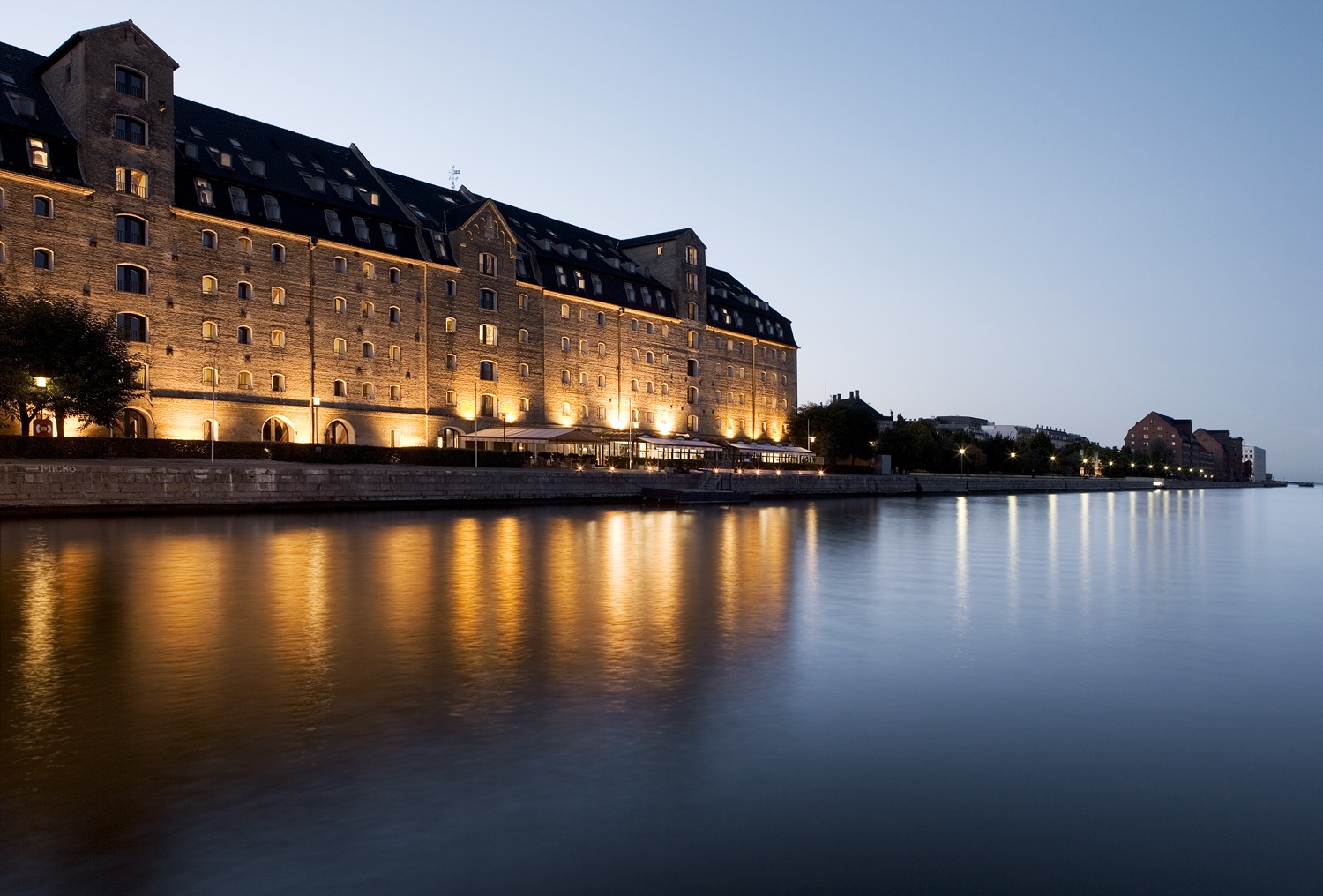
And if you choose not to walk, you may borrow--for about $4--one of the City Bikes available at 125 parking slots around town then simply return it when you're through and get your $4 back. There is also a fast, convenient, and on-time Metro system, which takes you to and from the airport in about 15 minutes.
I stayed at the Admiral Hotel (right), which is both centrally located and set right on the water in view of the splendid new Opera House. With 366 rooms, the Admiral is just the right size to accommodate business and tourist travelers with a sense of intimacy, especially since the maritime design of the hotel and rooms use rustic-looking wooden beams and teak furniture throughout to echo Copenhagen's seafaring history. The modern amenities are all here, and there is a fine restaurant here named Salt (which I shall be writing about next week in my restaurant round-up), where you can enjoy an extensive Danish buffet breakfast in the morning as part of the room rate.
Within walking distance of the hotel are the principal downtown sights, as well as the enchanting bronze statue of Hans Christian Anderson's Little Mermaid, which has, since 1913, been amiably anchored just steps from the water's bank, a location that has caused her more than once to be defaced and, once, beheaded. If you walk along the water
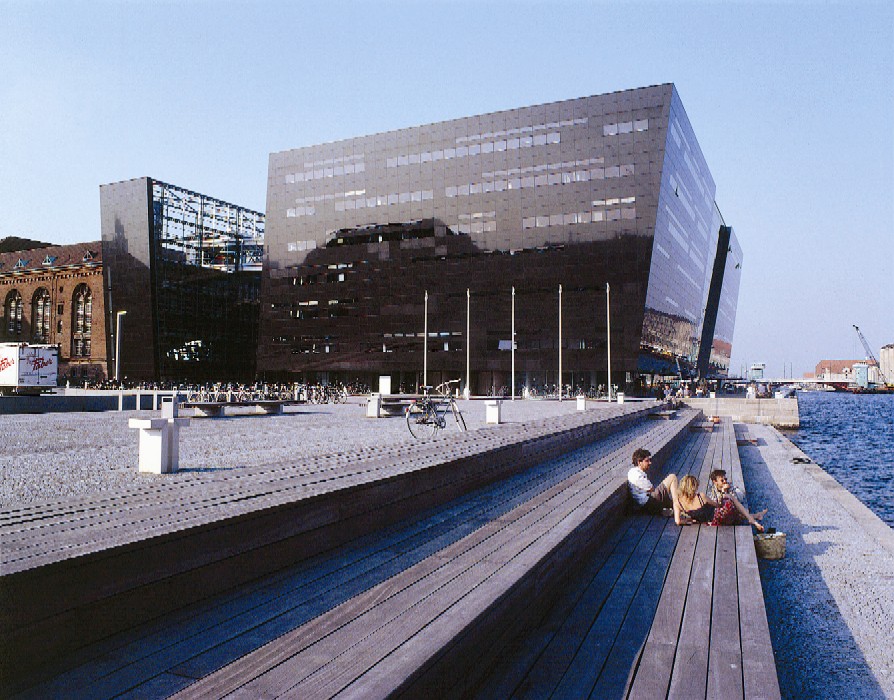 in
the other direction you will pass some of the great modern
architectural achievements of Danish design, including the Royal
Library, a solid and
angular chunk of
granite and dark glass that reflects the sparkling light from the water
so as to make its façade twinkle; hence its nickname "The Black
Diamond" (left). Across
the water is a series of elegantly minimalist office buildings of
the Unibank Headquarters by architect Henning Larsen.
in
the other direction you will pass some of the great modern
architectural achievements of Danish design, including the Royal
Library, a solid and
angular chunk of
granite and dark glass that reflects the sparkling light from the water
so as to make its façade twinkle; hence its nickname "The Black
Diamond" (left). Across
the water is a series of elegantly minimalist office buildings of
the Unibank Headquarters by architect Henning Larsen.Indeed, modern Danish design, which had tremendous global impact starting in the 1950s, has lost none of its evolutionary thrust, as might be gauged by the activities detailed at the Danish Architectural Centre and displayed at the Danish Design Centre, which are constantly showcasing young talents doing state-of-the-art work that ranges from chairs to lighting, from guitars to running shoes. Many of these are experimental or not in production, but for a very good look at what is available for purchase in furniture, objets d'art, carpets, and so many other items of contemporary Danish craftsmanship, visit one of the HAY stores. Renowned designers like Jakob Wagner, Leif Jorgensen, Peter Johansen, Anne Heinsvig, and Christian Uldall have their work for sale, and the HAY catalog is available online.
To catch up on modern Danish art, it is requisite to visit the beautifully designed and ever-growing
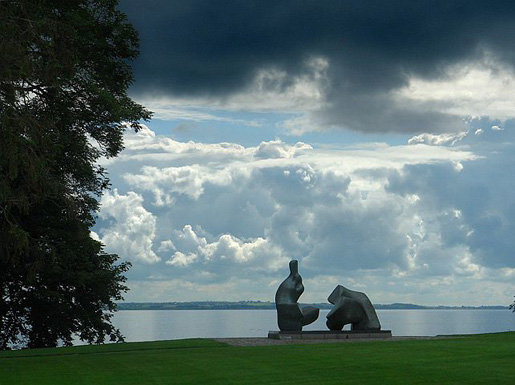 Louisiana Museum of Modern Art in
northern Zealand, set within a landscaped park (right) overlooking the
Øresund Sound. With more than 3,000 works, a teeming gift shop,
children's rooms, and a café, this makes for a day's outing,
though the principal works, including an extensive Manga exhibition,
can be seen in a morning or afternoon.
Louisiana Museum of Modern Art in
northern Zealand, set within a landscaped park (right) overlooking the
Øresund Sound. With more than 3,000 works, a teeming gift shop,
children's rooms, and a café, this makes for a day's outing,
though the principal works, including an extensive Manga exhibition,
can be seen in a morning or afternoon.Yet despite its pride in modernity, Copenhagen is an ancient city, founded in 1167 by Bishop Absalon on the two islands of Zealand and Amager. The great Anglo-Saxon epic Beowulf is set in Denmark, and the Viking heritage is rife throughout the culture. While central to numerous wars over the centuries, many with their neighbor across the sea, Sweden, Copenhagen itself did not suffer extensive damage in World War II after being occupied by the Germans. Thus, the great older monuments stand much as they were, though well restored, often by prominent architects. The center of the city, dominated by Tivoli itself, is flanked by the City Hall Square and Latin Quarter, where you'll find the more indigenous boutiques of arts, crafts, and clothes; nearby is the main shopping street, Strøget, closed to motor traffic, whose occupants are far more international brands. Nearby you'll find the National Museum, which has an impressive collection of Viking art and antiquities, and the Glyptoket Museum (below), spectacular not just for its own architecture but for its beautiful modern interiors housing the ancient artwork of Rome, Greece, Assyria, and,
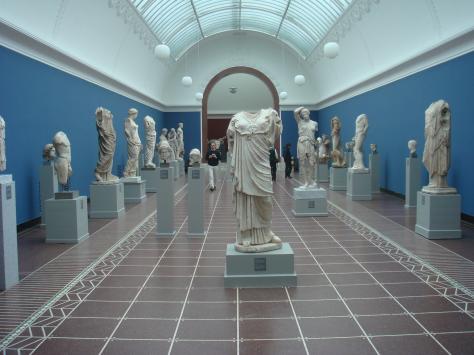 in a
wonderfully evocative, almost eerie subterranean series of rooms, some
very fine Egyptian art. Founded by brewer Carl Jacobsen, the
Glyptoket was intended as a sculpture showcase, and the collection is
built around a leafy interior, skylighted winter garden of a kind
that once distinguished art museums. To one side is a
café, whose desserts are far better than the savory offerings
here.
in a
wonderfully evocative, almost eerie subterranean series of rooms, some
very fine Egyptian art. Founded by brewer Carl Jacobsen, the
Glyptoket was intended as a sculpture showcase, and the collection is
built around a leafy interior, skylighted winter garden of a kind
that once distinguished art museums. To one side is a
café, whose desserts are far better than the savory offerings
here.All within walking distance of these attractions, is the now quaint, if once notoriously roustabout, Nyhavn canal district where fisherman lived, worked, drank, and took their pleasures with the women of the streets. These days Nyhavn is a more sanitized, colorful neighborhood lined with boutiques and cafés, and you should definitely consider one of the 60-minute boat tours that leave from here and take you around the principal waterways of the city.
Also in city center is Amalienborg, Queen Margaret II's winter residence, four façades shaped around an octagonal courtyard centered by an equestrian statue of the King Frederik V, who abruptly took over these four palaces from noble families after his own palace burned down in 1794. Further away two other palaces bear visiting--Frederiksborg Castle in Hillerød, now home to the Museum of National History, and Kronburg Helsingør, called Elsinore by Shakespeare as the setting for his 1599 drama "Hamlet," although no actual Prince of Denmark by that name has ever been proven to exist. The former castle is huge and vast, a 17th century testament to the pomp and self-importance of the Renaissance Danish kings. The latter dates to 1420, although most of what you now see is from the 16th century, built as a bulwark against Swedish invasion.
One of the sweetest of attractions outside of Copenhagen is the home of Baroness Karen Blixen, who,
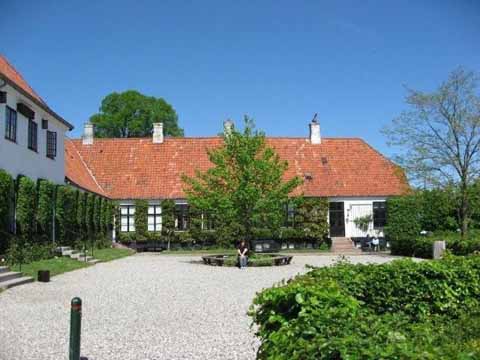 under the pen name Isak Dineson, wrote Seven Gothic Tales (1934), Out of Africa (1942) and several
other books and collections that established her as Denmark's most
famous author of the 20th century. Hemingway said she, not he,
should have received the Nobel Prize in 1954.
under the pen name Isak Dineson, wrote Seven Gothic Tales (1934), Out of Africa (1942) and several
other books and collections that established her as Denmark's most
famous author of the 20th century. Hemingway said she, not he,
should have received the Nobel Prize in 1954.Opened in 1991, Blixen's residence in Rungstedlund (right) is now in impeccable shape, and while the décor and furniture have been lovingly restored, this was not a house of great creature comforts. Her desk and her dining room and all the things dear to her are still arrayed here, with the addition of rooms containing editions of all her works, photographs, letters, memoirs, and fine paintings of the Kenyans she wrote about in Out of Africa.
Having spent almost 18 years in Kenya on a coffee farm--the basis for the romantic 1985 Meryl Streep/Robert Redford movie--she returned to her Danish home in 1931, became a famous, if not particularly wealthy writer, and died in 1962 at the age of 77, supposedly of malnutrition after a life of chronic maladies. It is truly an author's house, as much as Jane Austin's in Hampshire, England, or Ernest Hemingway's in Key West, Florida, each with the spirit of the author still lingering in the nooks and eaves, linens and papers.
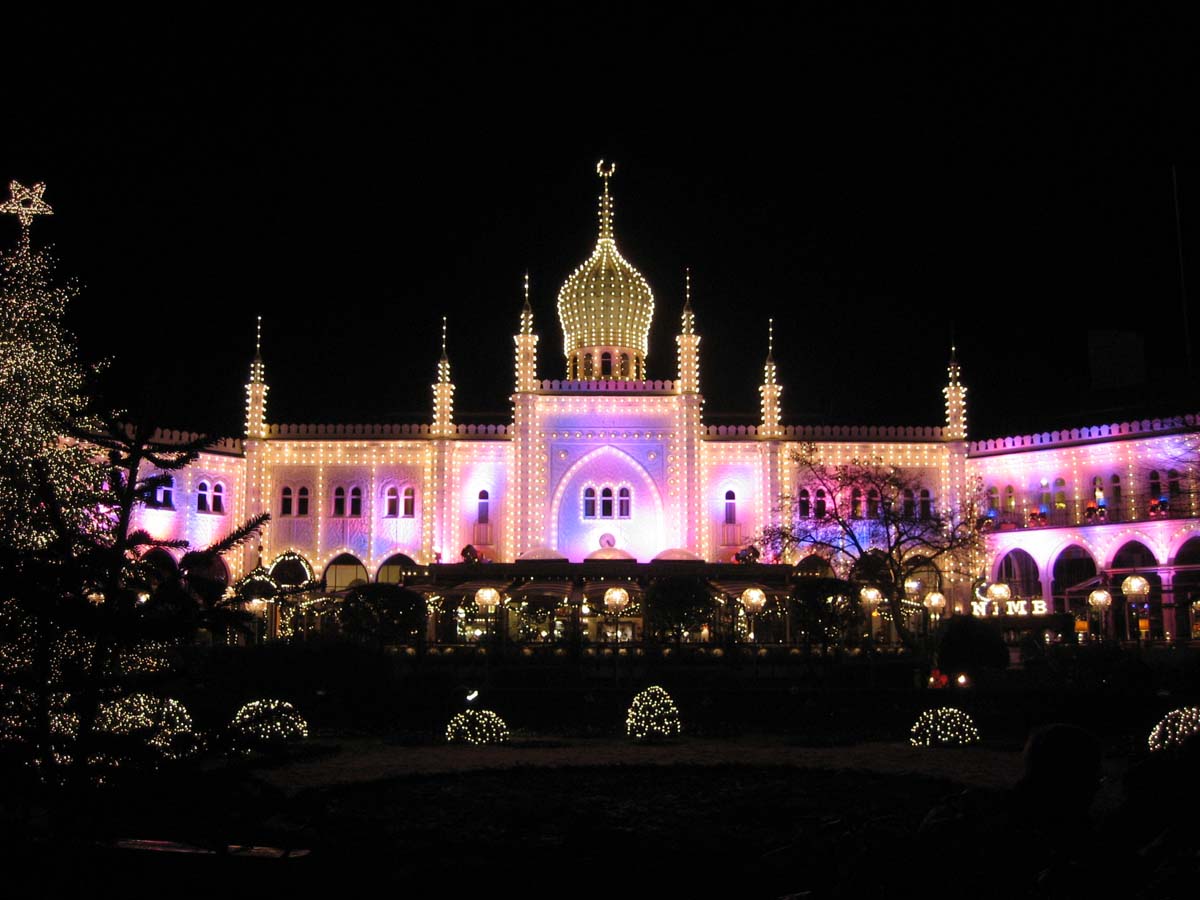 I have saved the most obvious of Copenhagen's attractions
for last: Tivoli Gardens,
which is open at
Christmastime, is a remarkable reverie plunked down smack in the center
of a capital city, as if Disneyland were located in downtown Los
Angeles. In fact, Walt Disney was the first to admit that his
inspiration for Disneyland in Anaheim came from visiting Tivoli, where
he found the kind of joys young children could thrill to without any of
the carny hustling, sideshows, and bad food of most American
amusement parks of the time. You can easily see what kinds of
attractions and rides eventually showed up in more modern guise in
Disneyland, especially the masted ship in the man-made lake here and
old-fashioned kiddie rides like that dramatizing Hans Christan
Anderson's best-loved stories.
I have saved the most obvious of Copenhagen's attractions
for last: Tivoli Gardens,
which is open at
Christmastime, is a remarkable reverie plunked down smack in the center
of a capital city, as if Disneyland were located in downtown Los
Angeles. In fact, Walt Disney was the first to admit that his
inspiration for Disneyland in Anaheim came from visiting Tivoli, where
he found the kind of joys young children could thrill to without any of
the carny hustling, sideshows, and bad food of most American
amusement parks of the time. You can easily see what kinds of
attractions and rides eventually showed up in more modern guise in
Disneyland, especially the masted ship in the man-made lake here and
old-fashioned kiddie rides like that dramatizing Hans Christan
Anderson's best-loved stories.The Gardens' creator, Georg Carstensen, said in 1843 that “Tivoli will never be finished,” and of course it has grown and been transformed ever since, not least through dazzling displays of electronics, lights, and computer generated thrills--not least a roller coaster called The Demon. There is a glass concert hall, pantomine theater, aquarium, and several restaurants, from the Michelin starred Groften and Restaurant Herman, and the new Nimb, a brasserie overlooking the Gardens. (I shall report more on these and other restaurants in Copenhagen next week.) Yet Tivoli has happily managed to maintain the childlike scope and wonder Carstensen originally envisioned for his gardens.
A FEW TIPS ABOUT VISITING COPENHAGEN
* The handy and economical Copenhagen Card costs DKK 199 (about $42) for 24 hours or DKK 429 ($90) for 72 hours, allowing free entry to more than 60 museums and attractions (Tivoli not included) throughout the metropolitan region, along with free transportation by train, bus, or Metro. You may purchase them at train stations, the airport, tourist info centers, and many hotels.
* Taxis are all licensed and may be flagged down anywhere. All drivers speak English and almost all accept credit cards. Let him know you will be paying with a card before you begin the trip.
* In fact, you can purchase just about anything--small or large--by credit cards. ATM machines are available throughout the city.
* In an emergency dial 112.
* Stores and boutiques have since 2005 been granted up to 23 Sundays to be open throughout the year.
* Tipping is not necessary anywhere, including at restaurants, hotels, and taxis. Rounding off a bill is common for good service.
Next Week: Dining Out in Copenhagen
~~~~~~~~~~~~~~~~~~~~~~~~~~~
NEW
YORK CORNER
A
Troubling Year for NYC Restaurants. . . and the BEST NEW RESTAURANTS OF 2008
by John Mariani
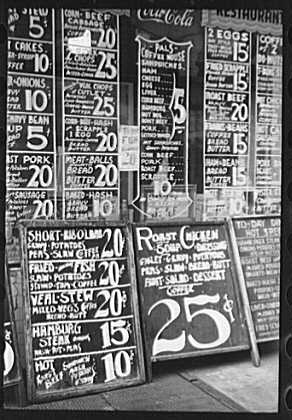 It
was not
exactly a year like any other in NY's gastro-scene. Plenty of
restaurants opened in 2008, some with big names attached. Many closed.
It
was not
exactly a year like any other in NY's gastro-scene. Plenty of
restaurants opened in 2008, some with big names attached. Many closed.
But the
downturn in the economy, beginning last summer, has wreaked havoc
within the restaurant industry nation- and city-wide, and in January,
usually the slowest month of the year for dining out, we can expect to
see a major shake-up and fall-out, just as in every other
industry. Restaurants are, of course, a little different than,
say, a car dealership, Broadway theater, or men's store.
Expenditures of several thousands of dollars are the ones immediately
reconsidered in a falling economy, while New Yorkers still cling to the
idea that, by cutting back a bit,
they can still enjoy a night
out--they need a night out,
they crave a night out. What
they no not need is to order
$350 bottles of Tuscan wines, $300 Kobe steaks, and $100 for an ounce
of white truffle shavings. Driven by Wall Streeters drunk on
greed, outrageous restaurant bills were part of the corporate perqs,
just like
bonuses, and such people never blinked twice at $500 checks at sushi
bars or 12-course meals at three-star restaurants. That has all now
changed. Simply being seen going into a three-star restaurant has
taken on a certain onus among certain strata of society, and the
exquisite boast that one could always get a table at such-and-such a
restaurant now sounds like shallow swaggering.
The bad and good news is that every
restaurateur I've
spoken with in NYC has felt the crunch but is trying very hard to make
their restaurants more affordable and more accessible. Winelists
once heavy in $100+ bottles are now adding more wines under $50.
Dover sole and foie gras are being appended with lesser species and
more interesting terrines and pâtés. Chefs have been
forced to be
creative with cheaper ingredients--including lobster!, which has
dropped
in price by half this year. And, according to my butcher, the
prices of beef and pork will plummet after the turn of the year because
they were kept (unsuccessfully) artificially high during the
holidays. Menu prices themselves have not dared to creep up as
they did a year ago, when the $45 main courses was becoming the norm
at high-end restaurants. Even Alain Ducasse at his new
restaurant Adour in the St. Régis is charging considerably less
for a meal than he had back in 1999 when he opened his first NYC
restaurant in what was then the Essex House. And
nobody has been
spending $10 million to open the next big deal. These days a
restaurateur would be lucky to get a loan for any amount of money to
open a storefront eatery on the Lower East Side.
Most important, restaurants with less
stellar credentials and far less posh have gotten so good at pleasing
the public's taste for pastas, stews, even vegetable dishes, that to
spend the extra $50 a head for the three-star experience is not as
appealing as it once was.
Value, however, is still value at the right
price. Let me share with you a wonderful e-mail I received from
the great chef Jean-Louis Gerin of Restaurant
Jean-Louis in
Greenwich, CT--now almost a quarter century in business--which I think
puts things into perspective:
"Yes, '08 was a
trying year. I was interviewed many, many, many times by international
and local press as to how Restaurant JEAN-LOUIS was going to survive
the crisis. My answer to them and to you is that I strongly
believe we are a 'great Value' restaurant. We enjoy a faithful customer
list that evolves with time. We now cook for the kids and grandkids of
our 90' client's list, while building our Internet contact list and
take home sales.
"Why? Simply because we never took advantage of you. When
asked if I am going to drop my prices, my answer is clear: I was
never overpriced, therefore I do not have any reason to discount
my food. And at Restaurant JEAN-LOUIS my cuisine is served on
Bernardaud china plates, finest hand-made crystal and Christofle
silverware. This is the
level of sophistication you and I want. Eating on cheap
plates with bad silverware and mechanic glasses does not qualify as
being economically correct, it's just plain snob-stupid.
"Let's all raise our crystal glasses of finest
wine to an interesting 2009 year. I will be cooking for you. I will
only buy the best food available. I will continue to pile-up great
wines in our Grand Award Wine
Spectator wine cellar.
I will use the finest porcelain, silver
and crystal. BUT, I am encouraging you to take advantage of our amazing
$59 Ballade Menu, which we have had for 15 years. Nothing new here, no
gimmick, it was available all this time. Simply come
to Restaurant JEAN-LOUIS and have a great time knowing you
are safe with us."
So here are
what I
think were the best
restaurant openings in NYC this past year or so--in no particular
order. I hope they all thrive
in 2009. (Some of these write-ups are adapted from my Esquire article "The
Best New Restaurants in America 2008," others
from the Virtual Gourmet.
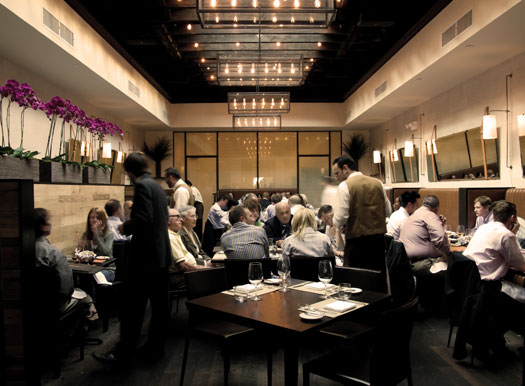 SCARPETTA--355
West 14th Street;
212-691-0555--The name of
the restaurant is a play on the
Italian word “scarpetta”
(“little shoe”), a colloquialism
for the crust of bread Italians use to clean their plates with, which
gives you an idea of the kind of gutsy food you’ll have
here. The word is also an alliteration of the
chef-owner’s name—Scott Conant.
SCARPETTA--355
West 14th Street;
212-691-0555--The name of
the restaurant is a play on the
Italian word “scarpetta”
(“little shoe”), a colloquialism
for the crust of bread Italians use to clean their plates with, which
gives you an idea of the kind of gutsy food you’ll have
here. The word is also an alliteration of the
chef-owner’s name—Scott Conant.
At Scarpetta you push your way past a loud bar
crowd into a skylighted
room with close-set tables, trattoria-style, and find the menu a screed
of lusty, well-spiced regional Italian food
included his signature roast capretto
(young goat), in all
its succulent goodness. Among the antipasti
is that old
Italian-American favorite mozzarella
in carozza—mozzarella
oozing
through a fried crust, cooked with stewed baby tomatoes. Meltingly
braised beef ribs cuddle next to farro
risotto, while his crudi is
called ‘susci--lustrous,
sweet raw tuna
with preserved
truffles. Pastas pack punch: tagliatelle
with
a lamb ragù and fresh peas; ricotta raviolini with a
subtle-salty benediction of anchovy butter and orange zucchini
blossoms; big fat duck and foie gras ravioli slippery with a
Marsala reduction. Go
simple with the main courses, maybe,
seared, pearl-white sea scallops with mushrooms
and sunchoke puree, or orata with
leeks and a fregola ragù.
It’s
a good bet you’ll be scooping up everything with a crust of
bread.
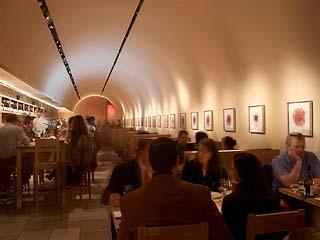 BAR BOULUD--1900
Broadway; 212-595-0303--Daniel Boulud grew up in Lyons, where
his family ran a
little café and his maman spoiled
him with the rich dishes of
the region and homemade charcuterie. Decades later, having
established himself as one of America’s greatest cuisiniers at his
namesake restaurants Daniel, Café Boulud, and DB Bistro Moderne,
he has come full circle with Bar Boulud, and he has clearly poured his
heart and soul into it.
BAR BOULUD--1900
Broadway; 212-595-0303--Daniel Boulud grew up in Lyons, where
his family ran a
little café and his maman spoiled
him with the rich dishes of
the region and homemade charcuterie. Decades later, having
established himself as one of America’s greatest cuisiniers at his
namesake restaurants Daniel, Café Boulud, and DB Bistro Moderne,
he has come full circle with Bar Boulud, and he has clearly poured his
heart and soul into it.
By bringing over a charcuterie master named
Sylvain Gasdon from Paris’ renowned Gilles Verot, Boulud has been able
to reproduce the lusty flavors of Lyonnaise-style artisanal sausages, fromage de tête, joue de
porc, compotée de lapin,
pâté grand-mère, pâté de campagne aux
foies de volaille, andouille de Vire, saucisson cuit à l’ail,
pâté en croûte, and much more. You will
never
taste any better.
Sit at the counter in the gold,
barrel-ceilinged dining room or the “Tasting Table in the Round” in the
rear, point to this and that, and tuck in your napkin. Or take a booth
along the wall and order any of the bourgeois classics prepared by Chef
Damian Sansonetti, accompanied by sturdy regional wines and excellent
bread and butter. Give up all hope of restraint in the face of
“Plats de résistance”
that include a simmering coq au vin
with
fresh pasta, lardons, onions, and mushrooms, and a thick, braised
flatiron steak with carrot mousseline and onion confit. If steak frites
is your measure of a good French bistro, you‘ll rave over the
textbook version here, and if you’re mad about blood sausage
Gasdon’s boudin noir will leave you grinning like a vampire. Then
perhaps some ripe cheeses or a rich, custard-filled gâteau
basque, with brandied cherries, and you’ll realize what a lucky
little
boy Daniel Boulud must have been back in Lyon.
 BAR BLANC--142
West 10 Street; 212-255-2330--Enthusiasm and a generosity of
spirit should always
trump hype and heat. When you experience the kind of dedication and
genuine hospitality at a small jewel like Bar Blanc, you can’t help but
cheer it on, even if you’d prefer to keep it to yourself. Set in
a former carriage house on one of the
prettiest streets of the West Village, Bar Blanc is a long 60-seat
dining room with black lacquered walls with wine bottles in lighted
niches, white brick walls, white leather banquettes, and a 12-stool
white stone bar apparently favored by Carrie-Charlotte-Samantha-Miranda
wannabes. Partners Kiwon Standen and Didier Palange and
Chef Sebastiaan Zjip are clearly in business to please guests, so the
greeting is warm and the seating always comfortable. Crispy sweetbreads
lie on watercress made tangy with lemon vinaigrette and sweetened with
Sherry-poached cherries. Seared black cod is underpinned with spinach,
roast sunchoke, and fennel, bathed in a saffron-mussel sauce. And, when
the strawberries are perfect, they need nothing
more than a light marinade, a tuffet of meringue, snow-white yogurt,
and a small scoop of strawberry sorbet—richly satisfying,
even homey. Now that I think of it, that’s exactly how an evening
at Bar Blanc could be described, and when you get up from the table the
owners seem really sorry you’re leaving.
BAR BLANC--142
West 10 Street; 212-255-2330--Enthusiasm and a generosity of
spirit should always
trump hype and heat. When you experience the kind of dedication and
genuine hospitality at a small jewel like Bar Blanc, you can’t help but
cheer it on, even if you’d prefer to keep it to yourself. Set in
a former carriage house on one of the
prettiest streets of the West Village, Bar Blanc is a long 60-seat
dining room with black lacquered walls with wine bottles in lighted
niches, white brick walls, white leather banquettes, and a 12-stool
white stone bar apparently favored by Carrie-Charlotte-Samantha-Miranda
wannabes. Partners Kiwon Standen and Didier Palange and
Chef Sebastiaan Zjip are clearly in business to please guests, so the
greeting is warm and the seating always comfortable. Crispy sweetbreads
lie on watercress made tangy with lemon vinaigrette and sweetened with
Sherry-poached cherries. Seared black cod is underpinned with spinach,
roast sunchoke, and fennel, bathed in a saffron-mussel sauce. And, when
the strawberries are perfect, they need nothing
more than a light marinade, a tuffet of meringue, snow-white yogurt,
and a small scoop of strawberry sorbet—richly satisfying,
even homey. Now that I think of it, that’s exactly how an evening
at Bar Blanc could be described, and when you get up from the table the
owners seem really sorry you’re leaving.
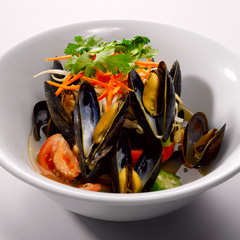 KAMPUCHEA--78 Rivington
Street; 212-529-3901--Hard to believe New York has only a single
Cambodian
restaurant. Fortunately, it is extraordinarily good and a helluva lot
of easygoing fun. “Kampuchea” is the Khmer word for Cambodia, and Chef
Ratha Chau, whose parents emigrated to the U.S., pays homage to
the street food of his native land with a panoply of exciting dishes
you won't find anywhere else. Kampuchea occupies a Lower East Side
storefront with large windows that allow you to catch the
comings-and-goings of the funky but quickly gentrifying Rivington
Street. With a few friends you get to make a large dent
in the menu of 18 small plates, 12 sandwiches, 5 crêpes, and 11
soups,
noodle dishes, and stews. You’ll fight over the chilled rice
vermicelli with grilled Berkshire pork, Chinese sausage, shallots, and
crushed peanuts, and an egg over easy. But you’ll
definitely keep the sandwiches all
to yourself. The num pang is
a plate of three of them, like coconut
tiger shrimp; sweet pulled oxtail with tamarind-basil sauce; and Hoisin
sauced meatballs with tomato sauce, and they’re all sensationally
good. Nosh your way through a catfish crêpe
with ground peppercorn, honey-soy, and sesame seed; crispy pork belly
with honey, scallions, and apple cider. And if you want to rave or
complain about the food,
Chau is standing there, just feet away in the open kitchen.
KAMPUCHEA--78 Rivington
Street; 212-529-3901--Hard to believe New York has only a single
Cambodian
restaurant. Fortunately, it is extraordinarily good and a helluva lot
of easygoing fun. “Kampuchea” is the Khmer word for Cambodia, and Chef
Ratha Chau, whose parents emigrated to the U.S., pays homage to
the street food of his native land with a panoply of exciting dishes
you won't find anywhere else. Kampuchea occupies a Lower East Side
storefront with large windows that allow you to catch the
comings-and-goings of the funky but quickly gentrifying Rivington
Street. With a few friends you get to make a large dent
in the menu of 18 small plates, 12 sandwiches, 5 crêpes, and 11
soups,
noodle dishes, and stews. You’ll fight over the chilled rice
vermicelli with grilled Berkshire pork, Chinese sausage, shallots, and
crushed peanuts, and an egg over easy. But you’ll
definitely keep the sandwiches all
to yourself. The num pang is
a plate of three of them, like coconut
tiger shrimp; sweet pulled oxtail with tamarind-basil sauce; and Hoisin
sauced meatballs with tomato sauce, and they’re all sensationally
good. Nosh your way through a catfish crêpe
with ground peppercorn, honey-soy, and sesame seed; crispy pork belly
with honey, scallions, and apple cider. And if you want to rave or
complain about the food,
Chau is standing there, just feet away in the open kitchen.
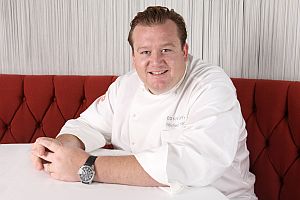 CONVIVIO--45
Tudor City; 212-599-5045--There
is never a let-up in the number of
new, exciting Italian restaurants in New York run by great chefs: This
year has seen the opening of Andy D’Amico’s Nizza (below), Scott Conant’s
Scarpetta (above), Centro
Vinoteca with chef Anne Burrell, and PadreFiglio with
Alberto Arguda—all very different but all serving with Italian food
that gets lustier all the time. So when Chris Cannon and Chef Michael
White
(left), previously at Fiamma,
reconfigured the highly regarded L’Impero
near the U.N. into a slightly more casual place named Convivio, I was
hardly surprised to find the food going in the direction of big
flavors, Cannon and White also run Alto in midtown, with a much
more elevated style of Italian cuisine. But when it comes to a
choice between Alto’s $88 four-course menu or the $59 option for the
same number at Convivio, and when that $59 gives you tomato-braised
octopus as a starter, then fusilli pasta
with Neapolitan pork shoulder
ragù and a melted fonduta
of cacciocavallo cheese, then
grilled
lamb chops with escarole and white beans, and ends off with a Sicilian
tart of nectarines, almond cream, and honey, where you gonna go?
In nice weather there’s a small patio
outside that overlooks the little park at Tudor City.
CONVIVIO--45
Tudor City; 212-599-5045--There
is never a let-up in the number of
new, exciting Italian restaurants in New York run by great chefs: This
year has seen the opening of Andy D’Amico’s Nizza (below), Scott Conant’s
Scarpetta (above), Centro
Vinoteca with chef Anne Burrell, and PadreFiglio with
Alberto Arguda—all very different but all serving with Italian food
that gets lustier all the time. So when Chris Cannon and Chef Michael
White
(left), previously at Fiamma,
reconfigured the highly regarded L’Impero
near the U.N. into a slightly more casual place named Convivio, I was
hardly surprised to find the food going in the direction of big
flavors, Cannon and White also run Alto in midtown, with a much
more elevated style of Italian cuisine. But when it comes to a
choice between Alto’s $88 four-course menu or the $59 option for the
same number at Convivio, and when that $59 gives you tomato-braised
octopus as a starter, then fusilli pasta
with Neapolitan pork shoulder
ragù and a melted fonduta
of cacciocavallo cheese, then
grilled
lamb chops with escarole and white beans, and ends off with a Sicilian
tart of nectarines, almond cream, and honey, where you gonna go?
In nice weather there’s a small patio
outside that overlooks the little park at Tudor City.
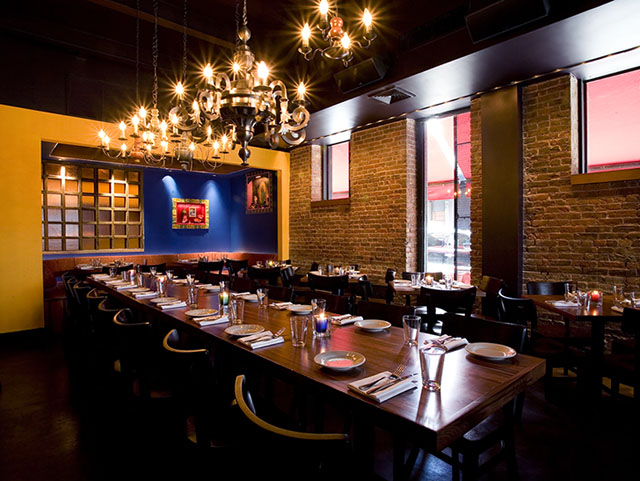 PAMPLONA--37
East 28th Street; 212-213-2328--Alex
Ureña
has quite a culinary résumé for such a young guy, earned
at Bouley, JoJo, and Blue Hill, so it was
inevitable he'd open his own place and break out with his own
ideas. Along the way he picked up valuable lessons from his
Dominican Republic family of good cooks, starting
with the
meatballs
with parsnip puree and a cranberry-tempranillo sauce. His
bocadillo
of braised rabbit with crema
de Cabra
goes down in a bite
or two, and you'll crave more. Patatas
bravas
are fried potatoes spiced with paprika and aïoli of
garlic-and-oil. and the bacalão
croquettes are traditional and very savory, just mild enough in flavor
but substantial.
You could stop after the tapas and entradas,
but then you'd miss the main courses like Alex's
succulent short ribs with white beans and tempranillo sauce, or one of
the three dishes he prepares for two people, like his juicy confit of cochinillo,
suckling pig with
caramelized apples, tender Swiss chard and the light sweetness of black
currants--a really marvelous dish.
PAMPLONA--37
East 28th Street; 212-213-2328--Alex
Ureña
has quite a culinary résumé for such a young guy, earned
at Bouley, JoJo, and Blue Hill, so it was
inevitable he'd open his own place and break out with his own
ideas. Along the way he picked up valuable lessons from his
Dominican Republic family of good cooks, starting
with the
meatballs
with parsnip puree and a cranberry-tempranillo sauce. His
bocadillo
of braised rabbit with crema
de Cabra
goes down in a bite
or two, and you'll crave more. Patatas
bravas
are fried potatoes spiced with paprika and aïoli of
garlic-and-oil. and the bacalão
croquettes are traditional and very savory, just mild enough in flavor
but substantial.
You could stop after the tapas and entradas,
but then you'd miss the main courses like Alex's
succulent short ribs with white beans and tempranillo sauce, or one of
the three dishes he prepares for two people, like his juicy confit of cochinillo,
suckling pig with
caramelized apples, tender Swiss chard and the light sweetness of black
currants--a really marvelous dish.
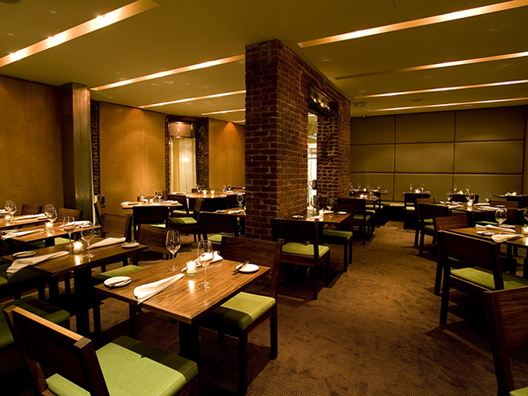 DOVETAIL--
DOVETAIL--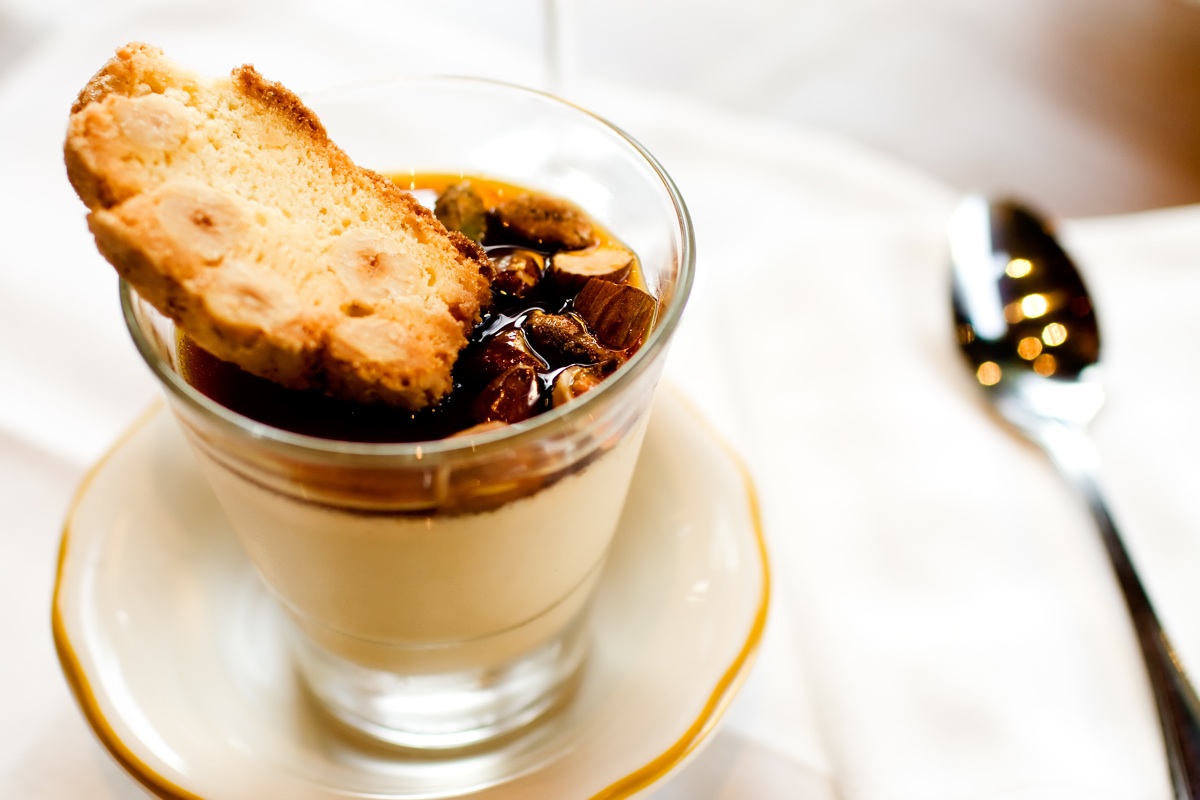 NIZZA--630 Ninth Avenue; 212-956-1800-- For decades now Andy
D'Amico has been among New York's top chefs, first
making his mark at long-gone Sign of the Dove, then opening his own two
fine
French bistros, Nice Matin and Marseilles. Now, with Nizza, he seems
more grounded than ever in providing the kind of rustic Italian
trattoria fare that is impossible not to love, especially the array of antipasti with Ligurian
regionalism. "Nizza" is
Italian for Nice, just across the Ligurian border, and they share many
of the same flavors. The storefront restaurant has just 65 seats
indoors, done in warm sienna brown and
ocher yellow, with a white marble bar, and a wall of wines (with 30
by the glass available). Among the antipasti
were irresistible foccaccette--fried
ravioli filled
with crescenza cheese; there
is a Ligurian torta layered
with Swiss chard and pancetta, and
one of
the best is roasted tomatoes with sheep's milk
ricotta. Just point to any pasta--pesto
lasagna with crescenza cheese
is
luscious; pansôti of
herbs and greens in a creamy walnut sauce is rich; and
the linguine with swordfish, tomato, pignoli, raisins and anchovies
mimics the cooking of Sicily. There's still more: wonderful pizza
with pancetta bacon, taleggio, red onion, and chile
flakes, and "terror stricken beef," a flat iron steak
marinated in fiery spices and served with shallots, capers,
anchovy and a vinegar sauce.
NIZZA--630 Ninth Avenue; 212-956-1800-- For decades now Andy
D'Amico has been among New York's top chefs, first
making his mark at long-gone Sign of the Dove, then opening his own two
fine
French bistros, Nice Matin and Marseilles. Now, with Nizza, he seems
more grounded than ever in providing the kind of rustic Italian
trattoria fare that is impossible not to love, especially the array of antipasti with Ligurian
regionalism. "Nizza" is
Italian for Nice, just across the Ligurian border, and they share many
of the same flavors. The storefront restaurant has just 65 seats
indoors, done in warm sienna brown and
ocher yellow, with a white marble bar, and a wall of wines (with 30
by the glass available). Among the antipasti
were irresistible foccaccette--fried
ravioli filled
with crescenza cheese; there
is a Ligurian torta layered
with Swiss chard and pancetta, and
one of
the best is roasted tomatoes with sheep's milk
ricotta. Just point to any pasta--pesto
lasagna with crescenza cheese
is
luscious; pansôti of
herbs and greens in a creamy walnut sauce is rich; and
the linguine with swordfish, tomato, pignoli, raisins and anchovies
mimics the cooking of Sicily. There's still more: wonderful pizza
with pancetta bacon, taleggio, red onion, and chile
flakes, and "terror stricken beef," a flat iron steak
marinated in fiery spices and served with shallots, capers,
anchovy and a vinegar sauce.
SOUTH GATE--154 Central Park South; 212-484-5120--The room
is a large, light, soaring
space, with the
ceiling a good 30 feet above your head, walls covered with small
mirrored tiles inset at differing angles so each reflection is slightly
different from its neighbor’s, and big comfortable chairs around
well-appointed tables separated by wide-open spaces. Chef Kerry
Heffernan, formerly at Eleven Madison Park, is doing warm-hearted food,
like a flan
of English peas with a few strips of prosciutto, a few
tiny morels, and a chervil emulsion. Mayan shrimp and leeks
vinaigrette with cardamom, rocket
and dill, all add up to a nicely acidic provocation to the palate.
The smoked char was as sweet as the morning’s catch, with flavor as
fresh, clean, and delicate as the grapefruit sections seasoned with
savory that accompanied it. Delicious oven-roasted Colorado
lamb, another doll-sized portion of loin, came with a generous
cassoulet, deconstructed so it was light and savory, along with tat soi, an Asian, small-leafed
green used mostly for salads, and a marjoram gremolata. The
chocolate pot-de-crème was excellent, as were its garnish, a
perfect chocolate madeleine, and little balls of chocolate as crisp and
crunchy as their name, chocolate craquante,
would suggest.
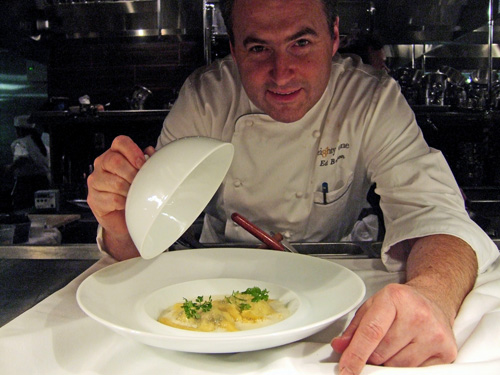 Eighty
One--45 W 81st Street; 212-873-8181--Chef Edward Brown spent 17 years at the
Sea Grill and now has re-appeared in his own restaurant. near the
Museum of Natural History. Eighty One is a deep, broad restaurant
with
high-backed booths, deep red lipstick colors, and polished wood floors.
The
tables are well set with the finest napery, stemware, and silverware,
the winelist
is very strong on every count, and service is amiable throughout the
evening, well attuned to the pacing of the kitchen.
Brown's
modern American cuisine shows the deft way he focuses on fish
species to bring out their best, as well as with meat, fowl, and
vegetables. He combines foie gras and chicken in a terrine, light
and mild, with baby
arugula, celeriac, apples, and truffles. Wonderful New Bedford
sea scallops and foie gras ravioli in a chervil-based wine sauce makes
for a refined starter. He
cooks fluke on the Spanish griddle, giving it a gentle sear, then
combines it with summer's vegetables in a fresh lemon-thyme broth. And
Colorado lamb comes two ways,
with roasted baby zucchini and the lovely creamy touch of ricotta. You
can taste in every dish the finesse and respect he has for the
principal ingredients, because they are always top of the season.
Eighty
One--45 W 81st Street; 212-873-8181--Chef Edward Brown spent 17 years at the
Sea Grill and now has re-appeared in his own restaurant. near the
Museum of Natural History. Eighty One is a deep, broad restaurant
with
high-backed booths, deep red lipstick colors, and polished wood floors.
The
tables are well set with the finest napery, stemware, and silverware,
the winelist
is very strong on every count, and service is amiable throughout the
evening, well attuned to the pacing of the kitchen.
Brown's
modern American cuisine shows the deft way he focuses on fish
species to bring out their best, as well as with meat, fowl, and
vegetables. He combines foie gras and chicken in a terrine, light
and mild, with baby
arugula, celeriac, apples, and truffles. Wonderful New Bedford
sea scallops and foie gras ravioli in a chervil-based wine sauce makes
for a refined starter. He
cooks fluke on the Spanish griddle, giving it a gentle sear, then
combines it with summer's vegetables in a fresh lemon-thyme broth. And
Colorado lamb comes two ways,
with roasted baby zucchini and the lovely creamy touch of ricotta. You
can taste in every dish the finesse and respect he has for the
principal ingredients, because they are always top of the season.
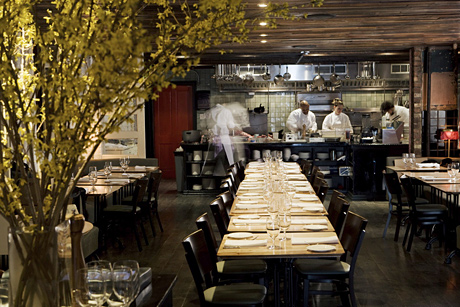 ELETTARIA--33 West 8th Street ; 212-677-3833--Chef
Akhtar Nawab and partner-manager
Noël
Cruz have brought ideas and spices to a menu
that refines the street food of those countries while making more
western ingredients like pheasant and quail sing in ways I have
not
come across before. The 72-seat restaurant has a cheery,
rustic ambiance, with a good polished steel bar, reclaimed barn-wood
ceiling, plank floorboards, and old brick walls in what is a landmarked
Greenwich Village building. You and
your friends could easily make a
meal by ordering all the appetizers, which include plenty of winners:
Kona kampachi raw fish with
jackfruit, hearts of palm, and the crunch
of smoked peanuts. Pork ribs are dusted with garam masala that perfumes the air,
with the soft meat surrendering to the bite, served with snow peas,
lychee, and cool yogurt. Bavette, a
delicious, thin cut of the short loin of
beef, was impeccably chewy, served simply with oyster mushrooms,
turnips, and the scent of fenugreek. Black sea bass with a confit of
fingerlings (good idea) was served with coconut, tapioca, and pea
leaves to provide varying textures. For dessert the "milk donuts,"
somewhat
like
Indian rasmalai, are soaked
with rosewater and you get the lagniappe of ginger custard and yogurt gelato.
ELETTARIA--33 West 8th Street ; 212-677-3833--Chef
Akhtar Nawab and partner-manager
Noël
Cruz have brought ideas and spices to a menu
that refines the street food of those countries while making more
western ingredients like pheasant and quail sing in ways I have
not
come across before. The 72-seat restaurant has a cheery,
rustic ambiance, with a good polished steel bar, reclaimed barn-wood
ceiling, plank floorboards, and old brick walls in what is a landmarked
Greenwich Village building. You and
your friends could easily make a
meal by ordering all the appetizers, which include plenty of winners:
Kona kampachi raw fish with
jackfruit, hearts of palm, and the crunch
of smoked peanuts. Pork ribs are dusted with garam masala that perfumes the air,
with the soft meat surrendering to the bite, served with snow peas,
lychee, and cool yogurt. Bavette, a
delicious, thin cut of the short loin of
beef, was impeccably chewy, served simply with oyster mushrooms,
turnips, and the scent of fenugreek. Black sea bass with a confit of
fingerlings (good idea) was served with coconut, tapioca, and pea
leaves to provide varying textures. For dessert the "milk donuts,"
somewhat
like
Indian rasmalai, are soaked
with rosewater and you get the lagniappe of ginger custard and yogurt gelato.
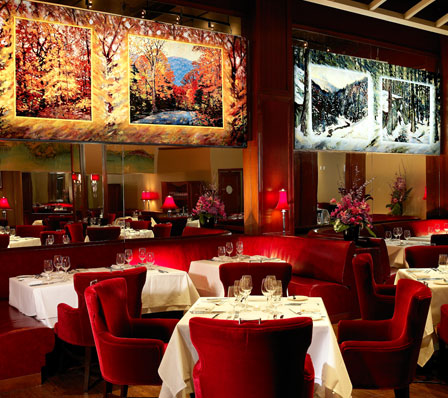 OLANA--72 Madison Avenue; 212-725-4900--Named
after the
fantastical estate of Hudson
River School painter Frederic Church, Olana's
décor was inspired by the grandeur of the Hudson Valley
mansions. Partner/Owners
William and Patrick Resk gave the rooms 17-foot ceilings, roomy
banquettes, leather paneled and mirrored walls, and mahogany blinds.
Chairs are wrapped in mohair, others in velvet, and good linens drape
the well-lighted tables. Hudson Valley artwork is displayed
throughout. Chef/owner Albert Di Meglio has a strong
résumé, with experience at Le Cirque and Osteria del
Circo. His food
has gusto and a very generous personality that comes through in the
largess of every dish. We began with roasted octopus with red
quinoa
and a garlic-rich rouille vinaigrette
and a fine
heirloom tomato salad with
crispy parmesan chops, a lacing of pesto,
and a chardonnay vinaigrette. DiMeglio's starter of sweetbreads and
langoustine lets the
two ingredients subtly play off each other, with the addition of a
celery-pancetta marmalade,
peppery purslaine, and a green apple-parsley
sauce adding numerous complementary flavors. We tried a hearty
trio of pastas on one dish ($20) as a main course--tacconi, tomato
risotto, and raviolini--all
very good. Monkfish osso buco,
nice and
meaty, came with a parsnip puree, and braised endive that gave it a
nice
bitter edge to go with the saline flavor of crisp lardons and an herb jus.
OLANA--72 Madison Avenue; 212-725-4900--Named
after the
fantastical estate of Hudson
River School painter Frederic Church, Olana's
décor was inspired by the grandeur of the Hudson Valley
mansions. Partner/Owners
William and Patrick Resk gave the rooms 17-foot ceilings, roomy
banquettes, leather paneled and mirrored walls, and mahogany blinds.
Chairs are wrapped in mohair, others in velvet, and good linens drape
the well-lighted tables. Hudson Valley artwork is displayed
throughout. Chef/owner Albert Di Meglio has a strong
résumé, with experience at Le Cirque and Osteria del
Circo. His food
has gusto and a very generous personality that comes through in the
largess of every dish. We began with roasted octopus with red
quinoa
and a garlic-rich rouille vinaigrette
and a fine
heirloom tomato salad with
crispy parmesan chops, a lacing of pesto,
and a chardonnay vinaigrette. DiMeglio's starter of sweetbreads and
langoustine lets the
two ingredients subtly play off each other, with the addition of a
celery-pancetta marmalade,
peppery purslaine, and a green apple-parsley
sauce adding numerous complementary flavors. We tried a hearty
trio of pastas on one dish ($20) as a main course--tacconi, tomato
risotto, and raviolini--all
very good. Monkfish osso buco,
nice and
meaty, came with a parsnip puree, and braised endive that gave it a
nice
bitter edge to go with the saline flavor of crisp lardons and an herb jus.
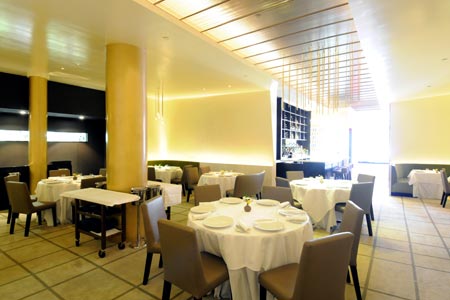 CORTON--239 West Broadway; 212-219-2777--The
closing two years ago of one of New York's seminal restaurants of the
late 1980s, Montrachet, quite possibly foretold the shift in
dining out that occurred as the economy slowed down. Its
replacement is the serenely cool Corton, a barely decorated dining room
in a minimalist style of pale Champagne
color walls, widely separated tables, soft lighting, and white
tablecloths set with Riedel, Laguiole, and Christofle. The chef is
something of a surprise:
British-bred Paul
Liebrandt, whose dubious
reputation with extremely experimental,
idiosyncratic cuisine and service at other restaurants seemed an odd
choice for owner Drew Nieporent. But Liebrandt has restrained himself
thus far, turning out beautiful modern cuisine like a simply perfect
baby
vegetables with fruits and herbs that taste like the first salad of
Eden,
while scallops take on a light brininess from the subtle use of sea
urchin cream, the crispness of radish and almonds, while caramelized
veal sweetbreads come with an oozing egg yolk "confit," carrot, and argan
oil--a superb dish. A rolled squab with chestnut cream, smoked
bacon and
foamy pain d'épices
milk, and for dessert Robert
Truitt's gianduja "palette"
gives you a heavenly trio of chocolate,
hazelnut, and tangy yuzu in profusion.
CORTON--239 West Broadway; 212-219-2777--The
closing two years ago of one of New York's seminal restaurants of the
late 1980s, Montrachet, quite possibly foretold the shift in
dining out that occurred as the economy slowed down. Its
replacement is the serenely cool Corton, a barely decorated dining room
in a minimalist style of pale Champagne
color walls, widely separated tables, soft lighting, and white
tablecloths set with Riedel, Laguiole, and Christofle. The chef is
something of a surprise:
British-bred Paul
Liebrandt, whose dubious
reputation with extremely experimental,
idiosyncratic cuisine and service at other restaurants seemed an odd
choice for owner Drew Nieporent. But Liebrandt has restrained himself
thus far, turning out beautiful modern cuisine like a simply perfect
baby
vegetables with fruits and herbs that taste like the first salad of
Eden,
while scallops take on a light brininess from the subtle use of sea
urchin cream, the crispness of radish and almonds, while caramelized
veal sweetbreads come with an oozing egg yolk "confit," carrot, and argan
oil--a superb dish. A rolled squab with chestnut cream, smoked
bacon and
foamy pain d'épices
milk, and for dessert Robert
Truitt's gianduja "palette"
gives you a heavenly trio of chocolate,
hazelnut, and tangy yuzu in profusion.
~~~~~~~~~~~~~~~~~~~~~~~~~~~~~~~~~~~~~~~~~~
NOTES
FROM THE WINE CELLAR
THE MYTH OF THE CHABLIS MONOLITH
by Brian Freedman
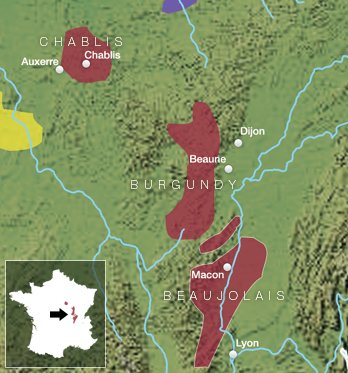 Outside of wine
circles, or among its most ardent fans, Chablis remains
stubbornly—indeed, bewilderingly—misunderstood. Some of this, of
course, is cultural: In America, those oversized jugs of “chablis,”
perfect for collecting dust or whipping up mediocre sangria, have done
more than their part in sullying the reputation of the real stuff. And
even among the more wine-knowledgeable, Chablis is often looked at
monolithically: As an always-crisp, typically austere, rock- and
mineral-driven Chardonnay that is perhaps best enjoyed as a quaffer.
Outside of wine
circles, or among its most ardent fans, Chablis remains
stubbornly—indeed, bewilderingly—misunderstood. Some of this, of
course, is cultural: In America, those oversized jugs of “chablis,”
perfect for collecting dust or whipping up mediocre sangria, have done
more than their part in sullying the reputation of the real stuff. And
even among the more wine-knowledgeable, Chablis is often looked at
monolithically: As an always-crisp, typically austere, rock- and
mineral-driven Chardonnay that is perhaps best enjoyed as a quaffer.
This, of course, could not be further from the
truth, as a very good vintage like 2006 proves.
In fact, a Domaine Laroche Chablis lunch this past
autumn at New York’s Daniel threw the supreme food-friendliness of
these wines into exquisitely sharp relief. And Chef Daniel Boulud’s
cooking, as his legions of fans know well, tends toward lusty, fully
developed flavors that shine beautifully on their own. So how, I
wondered, would Chablis, so supposedly austere, pair with it?
Perfectly, it turned out. Because just as is the
case with most every other great wine region or appellation around the
world, Chablis is home to a fabulously—if often subtly—varied terroir
whose differences in exposure, soil composition, and drainage result in
a far wider range of styles and expressions than popular perception
implies.
The Domaine
Laroche Saint Martin 2006, for example,
worked wonders alongside a complex tandoori cured striped bass. The
wine’s smoky, stony nose, flecked with hints of pepper, provided an
intriguing bridge to the aromatic intensity of the food. And even at
this affordable level (the Saint Martin generally retails for around
$23), its surprising density on the palate and juicy ripe apple
character played gorgeous counterpart even to a dish as supposedly
wine-daunting as this.
Moving up the ladder in terms of both prestige and
price, Chablis Premier Cru tends to be a step up in terms of both
nuance and expressiveness. The Laroche
1er Cru Les Vaudevey 2006, for
example, was sourced from a slower ripening, steep east-south-facing
slope that resulted in a wine of intriguing subtlety, a richly colored,
shimmering Chardonnay whose core of ripe stone fruit and minerals
clearly held a great deal still in reserve.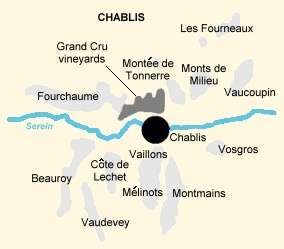
In contrast, the Laroche 1er Cru Les
Fourchaumes Vieilles Vignes 2006
lingered longer on the tongue and was richer with notes of vanilla and
lemon cream. These grapes were sourced from a sunny,
south-southwest-facing slope whose greater heat than Les Vaudevey’s
afforded the berries an earlier start to the ripening process. There
was still a striking nose of Granny Smith apple and telltale Chablis
minerality here, but this wine was heartier than its Vaudevey
counterpart. Despite their differences, however, both proved to be
excellent “food wines,” and paired seamlessly with Chef Boulud’s
butter-poached prawns with chorizo, glazed chayote, and avocado chutney.
Then there were the Grands Crus, the
greatest expressions of the best
terroirs in Chablis, all seven of which come from different parts of
the same 100-hectare hill. Still, the fact that the Grands Crus
neighbor one another doesn’t mean that there are not significant
differences between them; in fact, the proximity of one to the other
seems to highlight their individual characters.
The Domaine
Laroche Grand Cru Les
Blanchots 2006 almost reminded me of a white Rhone on the nose
with its
rich, waxy floral notes. On the palate, it demonstrated the density and
length that is so typical of the best of these wines. Their 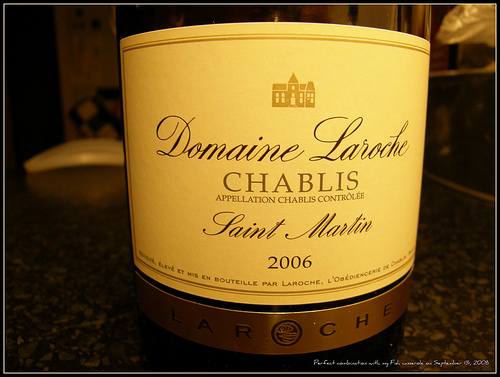 Grand Cru
Les Clos 2006, sourced from a climat right next to Les Blanchots
but
with exposure to a bit more southern sun (the two are divided by a thin
road), was a touch more lively on the mid-palate despite its greater
heft. It showed notes of flowers, chalk, and ripe pears, and promises
to evolve for another 5 – 15 years, though it’s hard to resist right
now, especially paired with a dish like restaurant Daniel’s rich,
earthy poulard with celery
root and porcini.
Grand Cru
Les Clos 2006, sourced from a climat right next to Les Blanchots
but
with exposure to a bit more southern sun (the two are divided by a thin
road), was a touch more lively on the mid-palate despite its greater
heft. It showed notes of flowers, chalk, and ripe pears, and promises
to evolve for another 5 – 15 years, though it’s hard to resist right
now, especially paired with a dish like restaurant Daniel’s rich,
earthy poulard with celery
root and porcini.
I’ve also been impressed with the 2006 Chablis from Domaine Faiveley. Their
Grand Cru Les Clos 2006 showed notable earth
and mushroom flavors and a nose reminiscent of almond skin and delicate
tea leaves. This wine was all about a sense of place, the transparency
of the color mirrored in the gorgeous transparency of the aroma. It’s
exactly the sort of wine that calls for purchasing several bottles and
following their evolution over the next decade or more.
Faiveley’s Grand
Cru Les Preuses 2006, on the other
hand, was a full-throttle, white Burgundy-style Chablis that showed a
nutty, toasty mid-palate, all density and reserved power right now,
that led the way to a finish that lingered on with grilled pineapple,
subtle candy corn, fresh lemon, and mineral notes. It’s an intriguing
wine, deliciously irresistible right now and still just at the
beginning of a long life.
A solid vintage like 2006, then, is perfect for
allowing each of the great terroirs of Chablis to shine. For consumers,
these wines offer a fantastic—and delicious—opportunity to explore this
too-often misunderstood region, and to discover all that the land
itself has to impart on the wines that come from it.
~~~~~~~~~~~~~~~~~~~~~~~~~~~
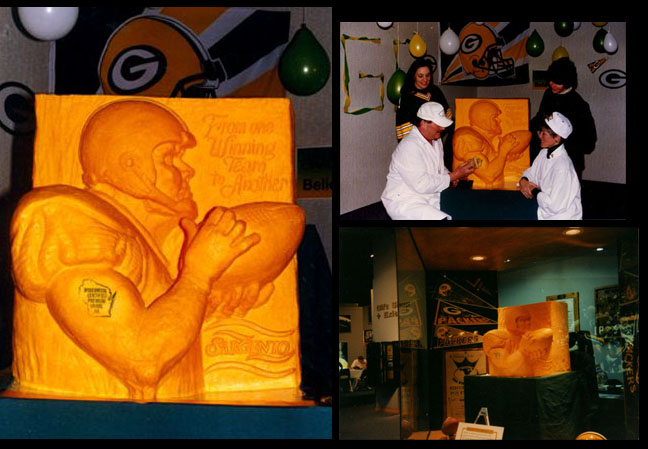 Follow
That Smell!
Follow
That Smell!
"From One Winning Team to Another," a
sculpture of the Green Bay Packers, was carved from a 640-pound block
of Sargento cheddar, for Sargento Foods, Inc. It was featured at
a NFL tailgate party where hungry fans gobbled half of it and then a
fan jumped on the table and ran off with the second head. Other
sculptures have incl 120-pound Mickey Mouse, a six-foot long aircraft
carrier, Jay Leno, Matt Lauer, Al Roker, Katie Couric.
MORE
STINKY STUFF! AND HOW
THOSE BRITS DO LOVE IT!
"Thankfully, this was
all background chatter compared with the next dish, les chipirons de ligne, hand-caught
baby squid sautéed with chorizo and tomato confit, surrounded by
two-year-old black rice and then swamped with Parmigiano Reggiano foam.
It sounds a disgusting mess of pretentious contradictions, but believe
me, this was the most exciting dish I have eaten in London for quite
some time. The Parmigiano exuded that rotten, durian-like stench that I
adore and the rice was almost as intense as black truffles--it was a
totally unique combination."--Bruce Palling, "Intelligent Life," The Economist.
TO ALL PUBLICISTS: Owing to the amount of material sent to this newsletter regarding New Year's dinners--many of which are only announcements as to price fixed dinners--it is impossible for me to include any but the most unusual of events for those holidays in Quick Bytes. --John Mariani
* From Jan.
14-19 Pueblo Bonito Oceanfront
Resorts and Spas presents the 1st Annual Cabo Wine & Food
Fest 2009 to celebrate Mexico’s wines and innovative gastronomy created
by award-winning chefs. sommeliers and vintners. will redefine
connoisseur’s perspectives of Mexican wines, spirits and beer.
Visit www.pueblobonito.com.
* On Jan. 14 meet "Dine About Town" chefs at a launch party in The Cellar at Macy's Union Square. With a $20 donation to Meals On Wheels, guests receive 10 "tasting tickets" to sample offerings, wine tastings and a keepsake Only in San Francisco wine glass.
* Dine
About Town San Francisco
returns Jan. 15-30, and June 1-15. Diners select from more than 100
Bay Area restaurants, each offering prix-fixe lunches for $21.95 and/or
dinners for $34.95. The restaurant list
will be posted on the web site
www.onlyinsanfrancisco.com/taste/dineabouttown. Call
415-391-2000.
*
On Jan. 17 & 18 “Sun
Winefest” will be held at Mohegan Sun
in Uncasville, CT, with
a wineries and breweries and chefs incl.
Todd English, Jasper White, Govind Armstrong, Mary Ann
Esposito, Pichet Ong, Douglas
Rodriguez, Susur Lee, Lydia Shire, Chris Schlesinger, Michael Ginor,
Walter Potenza, Loretta Oden, et
al. More than 1,000 wines, and exhibitors showcase
services such as wine
storage, culinary accessories and specialty foods. On Sat.
evening, a charity gala benefits the American Liver Foundation and
features Celebrity Chef Dine Around, Purchase online at
ticketmaster.com, or call 860.886.0070. Call 888-226-7711
or visit www.mohegansun.com.
* From now to Sept. in
Groton, CT, the Mystic Marriott Hotel
& Spa
offers a “Connecticut Wine Experience Package” in conjunction with two
of the state’s best vineyards, Jonathan Edwards’ award-winning wines
and learn more about the wine-making process during a special VIP
tasting. In addition, guests will also enjoy a wine tasting at
Stonington Vineyards and a complimentary bottle of wine. Packages are
$575. Call 860- 446-2600.
Everett Potter's Travel Report:

~~~~~~~~~~~~~~~~~~~~~~~~~~~~~~~~~~~~~~~~~~~~~~~~~~~~~~~~~~~~~~~~~~~~~~~~~~
Eating Las Vegas is the new on-line site for Virtual Gourmet contributor John A. Curtas., who since 1995 has been commenting on the Las Vegas food scene and reviewing restaurants for Nevada Public Radio. He is also the restaurant critic for KLAS TV, Channel 8 in Las Vegas, and his past reviews can be accessed at KNPR.org. Click on the logo below to go directly to his site.

~~~~~~~~~~~~~~~~~~~~~~~~~~~~~~~~~~~~~~~~~~~~~~~~~~~~~~~~~~~~~~~~~~~~~~~~~~~
Tennis Resorts Online: A Critical Guide to the World's Best Tennis Resorts and Tennis Camps, published by ROGER COX, who has spent more than two decades writing about tennis travel, including a 17-year stretch for Tennis magazine. He has also written for Arthur Frommer's Budget Travel, New York Magazine, Travel & Leisure, Esquire, Money, USTA Magazine, Men's Journal, and The Robb Report. He has authored two books-The World's Best Tennis Vacations (Stephen Greene Press/Viking Penguin, 1990) and The Best Places to Stay in the Rockies (Houghton Mifflin, 1992 & 1994), and the Melbourne (Australia) chapter to the Wall Street Journal Business Guide to Cities of the Pacific Rim (Fodor's Travel Guides, 1991). THIS WEEK: A Report on The Four Seasons Jackson Hole. Click on the logo below to go to the site.

Family
Travel
Forum: The
Family Travel Forum (FTF), whose motto is "Have Kids, Still Travel!",
is dedicated to the ideals, promotion and support of travel with
children. Founded by business professionals John Manton and Kyle
McCarthy with first class travel industry credentials and global family
travel experience, the independent, family-supported FTF will provide
its members with honest, unbiased information, informed advice and
practical tips; all designed to make traveling a rewarding, healthy,
safe, better value and hassle-free experience for adults and children
who journey together. Membership in FTF will lead you to new worlds of
adventure, fun and learning. Join the movement.
All You Need to Know Before You Go
~~~~~~~~~~~~~~~~~~~~~~~~~~~~~~~~~~~~~~~~~~~~~~~~~~~~~~~~~~~~~~~~~~~~~~~~~
MARIANI'S VIRTUAL GOURMET NEWSLETTER is published weekly. Editor/Publisher: John Mariani.
Contributing Writers: Robert Mariani,
John A. Curtas, Edward Brivio, Mort
Hochstein, Suzanne Wright, and Brian Freedman. Contributing
Photographers: Galina Stepanoff-Dargery, Bobby Pirillo. Technical
Advisor: Gerry McLoughlin.
Any
of John Mariani's books below
may be ordered from amazon.com by clicking on the cover image.
 My
newest book, written with my brother Robert Mariani, is a memoir of our
years growing up in the My
newest book, written with my brother Robert Mariani, is a memoir of our
years growing up in the For those of you who don't think of the Robert and I think you'll enjoy this very personal look at our --John Mariani |
 |
 |
 |
 |
 |
 |
© copyright John Mariani 2008